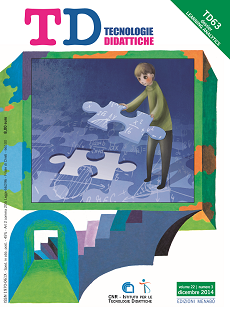Penetrare la nebbia: tecniche di analisi per l'apprendimento
Contenuto principale dell'articolo
Abstract
In questo articolo, viene evidenziato il valore delle tecniche di analisi dei dati per l’istruzione superiore, e presentato un modello di sviluppo per i dati legati all’apprendimento. Ovviamente, l’apprendimento è un fenomeno complesso, e la sua descrizione attraverso strumenti di analisi non è semplice; pertanto, l’articolo presenta anche le principali problematiche etiche e pedagogiche connesse all’utilizzo delle tecniche di analisi dei dati in ambito educativo. Cionondimeno, il Learning Analytics può penetrare la nebbia di incertezza che avvolge il futuro dell’istruzione superiore, e rendere più evidente come allocare le risorse, come sviluppare vantaggi competitivi e, soprattutto, come migliorare la qualità e il valore dell’esperienza di apprendimento.
Dettagli dell'articolo
Gli autori che pubblicano su questa rivista accettano le seguenti condizioni:
- Gli autori mantengono i diritti sulla loro opera e cedono alla rivista il diritto di prima pubblicazione dell'opera, contemporaneamente licenziata sotto una Licenza Creative Commons CC BY 4.0 Attribution 4.0 International License.
- Gli autori possono aderire ad altri accordi di licenza non esclusiva per la distribuzione della versione dell'opera pubblicata (es. depositarla in un archivio istituzionale o pubblicarla in una monografia), a patto di indicare che la prima pubblicazione è avvenuta su questa rivista.
- Gli autori possono diffondere la loro opera online (es. in repository istituzionali o nel loro sito web) prima e durante il processo di submission, poiché può portare a scambi produttivi e aumentare le citazioni dell'opera pubblicata (Vedi The effect of Open Access).
Riferimenti bibliografici
Anderson, C. (2008). The End of Theory: The Data Deluge Makes the Scientific Method Obsolete. Wired, 16(7). Retrieved from http://archive.wired.com/science/discoveries/magazine/ 16-07/pb_theory
Anderson, P. W. (1972). More Is Different. Science, 177(4047), 393-396. doi: 10.1126/science.177.4047.393
Brynjolfsson, E., Hitt, L. M., & Heekyung, H. K. (2011). Strength in Numbers: How Does Data-Driven Decision making Affect Firm Performance? Social Science Research Network - Working Paper Series. Retrieved from http://papers.ssrn.com/sol3/papers.cfm?abstract_ id=1819486
Campbell, J. P., DeBlois, P. B., & Oblinger, D. G. (2007). Academic Analytics: A New Tool for a New Era. EDUCAUSE Review, 42(4), 40-57.
Gelernter, D. (1999, December 31). The Second Coming: A Manifesto. Edge.org. Retrieved from http://edge.org/conversation/ the-second-coming-a-manifesto
Gross, W. H. (2011, July). School Daze, School Daze, Good Old Golden Rule Days. Pimco, All Investment Outlook. Retrieved from http://www.pimco.com/EN/Insights/Pages/ School-Daze- School-Daze-Good-Old-Golden-Rule-Days.aspx
Head, S. (2011, January 13). The Grim Threat to British Universities. New York Review of Books. Retrieved from http://www.nybooks.com/articles/archives/2011/jan/13/gri m-threat-british-universities/?page=1
Kirkpatrick, M. (2010, August 12). China Moves to Dominate the Next Stage of the Web. Readwrite. Retrieved from http:// www.readwriteweb.com/archives/china_moves_to_dominate_ the_next_stage_of_the_web_internet_of_things.php
Lacy, S. (2011, April 10). Peter Thiel: We’re in a Bubble and It’s Not the Internet, It’s Higher Education. Retrieved from http://techcrunch.com/2011/04/10/peter-thiel-were-in-abubble- and-its-not-the-internet-its-higher-education/
Macfadyen, L. P., & Dawson, S. (2010). Mining LMS data to develop an “early warning system” for educators: A proof of concept. Computers & Education, 54(2), 588-599.
Manyika, J. (2011). Big Data: The Next Frontier for Innovation, Competition, and Productivity. McKinsey Global Institute. Insights & Publications. Retrieved from http://www.mckinsey. com/insights/business_technology/big_data_the_next _frontier_for_innovation
Mayer, M. (2010, May 4). Innovation at Google: the physics of data [video]. Retrieved from http://www.slideshare.net/PARCInc/ innovation-at-google-the-physics-of-data
Morris, L. V., Finnegan, C., & Wu, S. (2005). Tracking Student Behavior, Persistence, and Achievement in Online Courses. The Internet and Higher Education, 8(3), 221-231.
Scism, L., & Maremont, M. (2010, November 19). Insurers Test Data Profiles to Identify Risky Clients. The Wall Street Journal. Retrieved from http://online.wsj.com/article/SB 10001424052748704648604575620750998072986.html
Thompson, C. (2011, July 15). How Khan Academy Is Changing the Rules of Education. Wired. Retrieved from http://www.wired. com/magazine/2011/07/ff_khan/all/1

